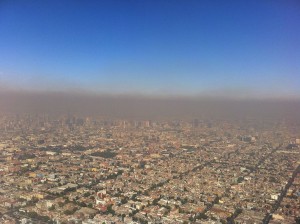21 April 2016
WASHINGTON, DC — If emission rates continue unchecked, regions of the United States could experience between three and nine additional days per year of unhealthy ozone levels by 2050, according to a new study.

In the lower atmosphere, sunlight reacts with nitrogen oxides, methane and other volatile organic molecules to produce ozone. At this level of the atmosphere, ozone acts as a pollutant, rather than a protectant, as shown in this aerial photo of Mexico City. New research shows that if emission rates continue unchecked, some regions of the United States could experience between three and nine additional days per year of unhealthy ozone levels by 2050.
Credit: Fidel Gonzalez via Wikimedia Commons.
“In the coming decades, global climate change will likely cause more heat waves during the summer, which in turn could cause a 70 to 100 percent increase in ozone episodes, depending on the region,” said Lu Shen, a graduate student at the Harvard John A. Paulson School of Engineering and Applied Sciences (SEAS) in Cambridge, Massachusetts and lead author of the new study.
California, the Southwest, and the Northeast would be the most affected, each possibly experiencing up to nine additional days of dangerous ozone levels, with much of the rest of the country experiencing an average increase of 2.3 days, according to the new study published today in Geophysical Research Letters, a journal of the American Geophysical Union.
This increase could lead to more respiratory illness with especially dangerous consequences for children, seniors, and people suffering from asthma.
“Short-term exposure to ozone has been linked to adverse health effects,” said Loretta J. Mickley, a research fellow at SEAS and co-author of the study. “High levels of ozone can exacerbate chronic lung disease and even increase mortality rates.”
While temperature has long been known as an important driver of ozone episodes, it’s been unclear how increasing global temperatures will impact the severity and frequency of surface level ozone.
To address this question, Shen and Mickley — with coauthor Eric Gilleland of the National Center for Atmospheric Research (NCAR) in Boulder, Colorado — developed a model that used observed relationships between temperature and ozone to predict future ozone episodes.
Previous research had not relied so heavily on existing observations, making projections uncertain. Shen and co-authors analyzed ozone-temperature relationships at measurement sites across the US, and found them surprisingly complex.
“Typically, when the temperature increases, so does surface ozone,” Mickley said. “Ozone production accelerates at high temperatures, and emissions of the natural components of ozone increase. High temperatures are also accompanied by weak winds, causing the atmosphere to stagnate. So the air just cooks and ozone levels can build up.”
However, at extremely high temperatures — beginning in the mid-90s Fahrenheit — ozone levels at many sites stop rising with temperature. The phenomena, previously observed only in California, is known as ozone suppression.
In order to better predict future ozone episodes, the team set out to find evidence of ozone suppression outside of California and test whether or not the phenomena was actually caused by chemistry.
They found that 20 percent of measurement sites in the US show ozone suppression at extremely high temperatures. Their results called into question the prevailing view that the phenomenon is caused by complex atmospheric chemistry.
“Rather than being caused by chemistry, we found that this dropping off of ozone levels is actually caused by meteorology,” Shen said. “Typically, ozone is tightly correlated with temperature, which in turn is tightly correlated with other meteorological variables such as solar radiation, circulation and atmospheric stagnation. But at extreme temperatures, these relationships break down.”
“This research gives us a much better understanding of how ozone and temperature are related and how that will affect future air quality,” Mickley said. “These results show that we need ambitious emissions controls to offset the potential of more than a week of additional days with unhealthy ozone levels.”
###
The American Geophysical Union is dedicated to advancing the Earth and space sciences for the benefit of humanity through its scholarly publications, conferences, and outreach programs. AGU is a not-for-profit, professional, scientific organization representing more than 60,000 members in 139 countries. Join the conversation on Facebook, Twitter, YouTube, and our other social media channels.
Notes for Journalists
This research article will be open access for 30 days from the date of publication. A PDF copy of the article can be downloaded at the following link: http://onlinelibrary.wiley.com/doi/10.1002/2016GL068432/abstract
After 30 days, journalists and public information officers (PIOs) of educational and scientific institutions who have registered with AGU can download a PDF copy of the article from the same link.
Journalists and PIOs who have not registered with AGU may order a copy of the final paper by emailing a request to Lauren Lipuma at [email protected].
Please provide your name, the name of your publication, and your phone number.
Neither the paper nor this press release is under embargo.
“Impact of increasing heatwaves on U.S. ozone episodes in the 2050s: Results from a multi-model analysis using extreme value theory”
Authors:
Lu Shen, Loretta J. Mickley: School of Engineering and Applied Sciences, Harvard University, Cambridge, Massachusetts, U.S.A.;
Eric Gilleland: Research Applications Laboratory, National Center for Atmospheric Research, Boulder, Colorado, U.S.A.
Contact Information for the Authors:
Lu Shen: [email protected]
Loretta J. Mickley: [email protected], +1 (617) 496-5635
Lauren Lipuma
+1 (202) 777-7396
[email protected]
Harvard University Contact:
Leah Burrows
+1 (617) 496-1351
[email protected]